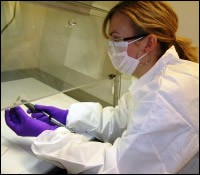01/30/06
 |
|
A
regional mtDNA biologist from Arizona
prepares a human bone for mitochondrial
DNA analysis.
|
In
December 1976, campers discovered the badly
decomposed remains of a young girl in a
heavily wooded area of the Florida Keys.
Despite an exhaustive effort by local police,
the girl could not be identified and the
investigation was relegated to the "cold
case" file.
Fast
forward to July 2004: Using a forensic
technique undeveloped in 1976—analysis
of maternally-inherited mitochondrial DNA,
or mtDNA, residing outside the nucleus of
human cells—scientists at the FBI
Laboratory in Quantico, Virginia, helped
identify the young girl as a Florida teenager
who had disappeared nine months before her
remains were found.
That
and similar mtDNA success stories are why,
in early November, we were pleased to announce
that regional crime labs in Arizona, Minnesota,
and New Jersey have now been fully equipped
by the FBI Laboratory to offer free mtDNA
analysis to law enforcement agencies nationwide,
with a fourth lab in Connecticut set to
open this spring.
Thanks
to this partnership, the nation's capacity
to perform mtDNA analysis is expected to
more than double in fiscal year 2006. So
why is this important? Because in cases
where we can obtain only small or degraded
quantities of DNA—such as with old
or charred remains—and nuclear DNA
(which resides inside the nucleus of human
cells) exams aren't possible, we can compare
mtDNA samples from hair, bones, or teeth
to the mtDNA in blood and/or saliva samples
from victims, suspects, or relatives of
missing persons to see if there's a match.
(To read more about what mtDNA analysis
is, when we use it, and why it's such a
valuable tool, see our top
story of September 13, 2004).
How
does our partnership with the regional crime
labs work? The labs—the Arizona
Department of Public Safety Central Crime
Laboratory, the Connecticut State Police
Forensic Science Laboratory, the Minnesota
Bureau of Criminal Apprehension Forensic
Science Laboratory, and the New Jersey State
Police Crime Laboratory—accept requests
for mtDNA analysis from law enforcement
agencies in the areas they serve and take
referrals from us. We ensure that the analyses
meet quality standards mandated by Congress
as well as pay for their related salaries,
supplies, and travel for testimony in court.
What
does all this mean to you and your communities?
Simply put, more missing persons identified
and more valuable information for solving
violent crime and terrorism cases.
Resources:
National
press release | The
FBI Lab


